Products made from ceramics have become part of man’s everyday life. Made traditionally using a kiln, this material finds application in the production of a wide range of optical, mechanical, and electrical appliances. Nonetheless, the current trend in ceramic product manufacturing is CNC machining.
CNC machining ceramics facilitates manufacturing parts and products with a unique feel and appearance. Ceramic parts made using a CNC machine also have excellent compressive endurance, unlike those made using a kiln.
So, what exactly does the process of CNC machining ceramics entail? What are the ideal materials and machining options for this process? Do read on as we examine the process of ceramic machining with CNC.
What is Ceramic CNC Machining?
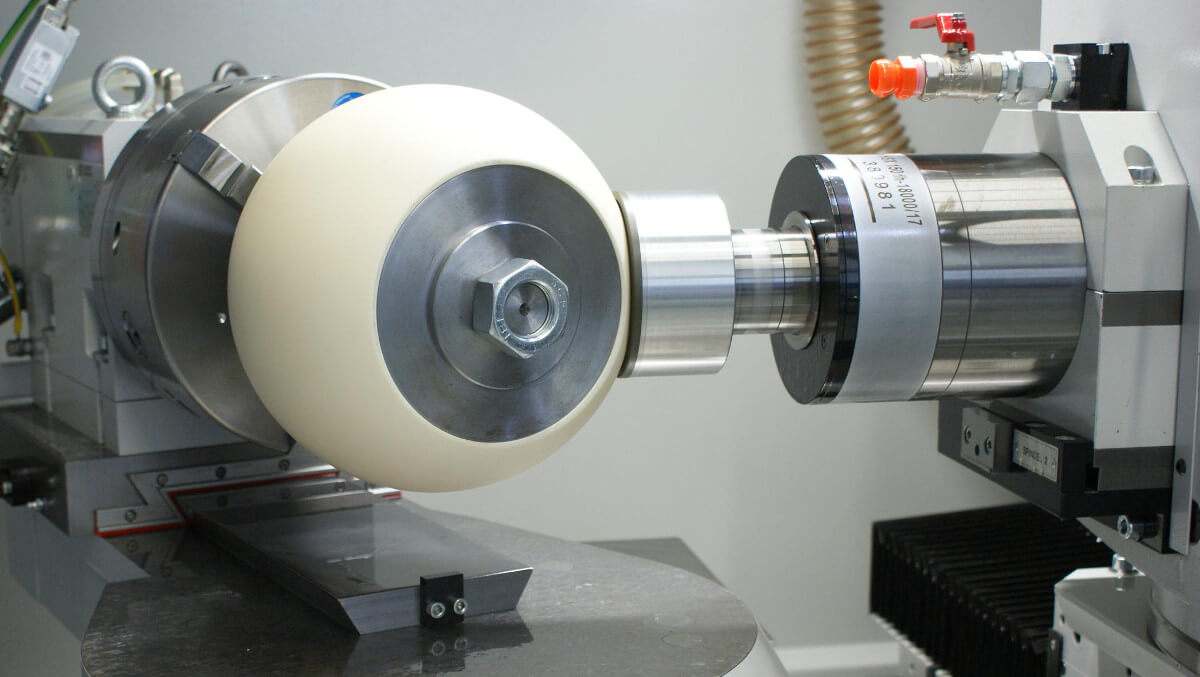
Ceramic CNC machining process involves cutting ceramic materials into different shapes using computer-controlled routers. Furthermore, cutting ceramics with a CNC machine allows for higher accuracy and control, improving cut precision. The rigidity and brittleness of ceramics make CNC machining the preferred process over traditional machining. It facilitates the creation of parts and products with complex shapes and tight tolerances.
First, the process of ceramic machining begins with creating a CAD model of the desired product, part, or shape. The next phase in the process is converting the CAD model into CAM. Computer-aided manufacturing (CAM) contains the G-code necessary for directing the toolpath of the CNC machining. Lastly, the machinist transmits the CAM code to the CNC machine, cutting the ceramic material using the specified toolpath.
Types of Ceramics for CNC Machining
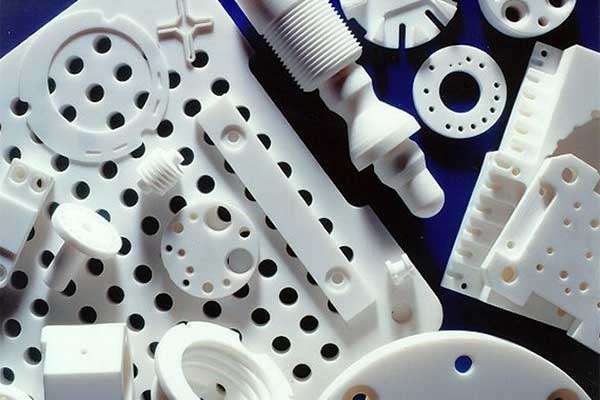
Not all ceramic materials are ideal for fabrication using the CNC machine due to their different mechanical, physical, and chemical properties. However, here are the ideal materials for CNC machining.
Alumina Ceramic
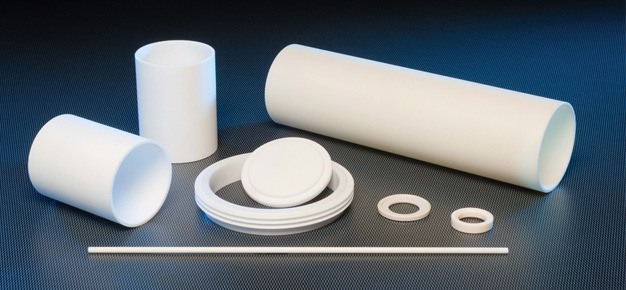
Alumina ceramic, also known as aluminum oxide, is a versatile and commonly used material. It has great high hardness, durability, good electrical insulation, high temperature resistance, and high corrosion resistance. In CNC machining, alumina ceramics are a popular choice for creating high-precision components. And parts used in diverse applications, such as aerospace, automotive, electronics, and medical devices.
Besides, the high hardness and wear resistance of alumina ceramics make them ideal for use in cutting tools. Though their high temperature resistance and good electrical insulation make them suitable for use in high-temperature and electrical applications.
Boron Nitride
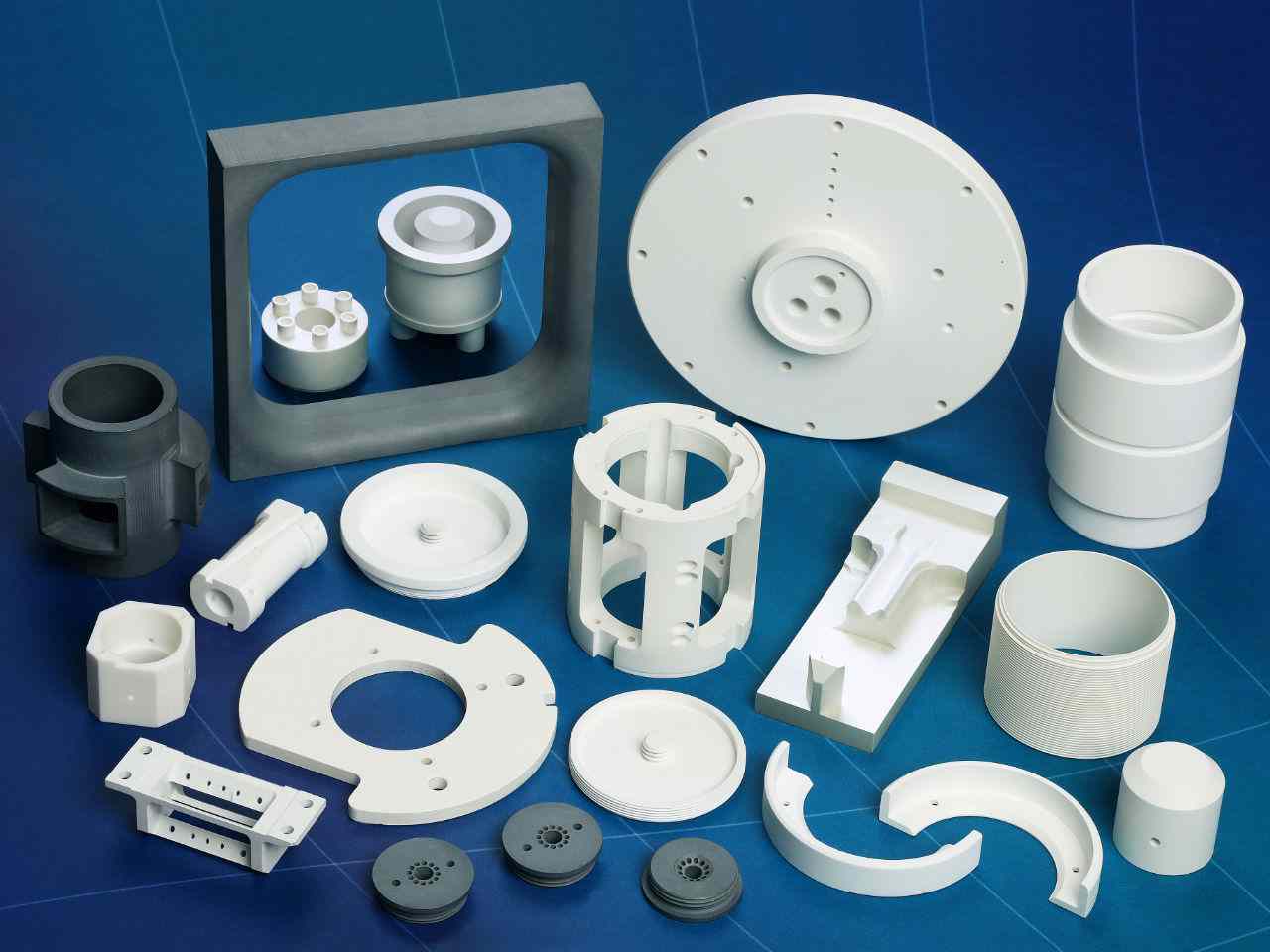
Composed of boron and nitrogen with a chemical formula BN, Boron Nitride, is a unique class of ceramics. It has a low dielectric constant, thermal expansion, and loss tangent. Furthermore, it is chemically inert, highly resistant to electricity, and has good resistance to thermal shock.
Produced as a hot-pressed solid, BN yields a platy crystal and hexagonal structure. This makes machining the material to create complex parts with close tolerance possible.
Additionally, Boron Nitride ceramic parts do not require firing or heat treatment before being ready. These thermal properties of Boron nitride give it application in a variety of industries, including the semiconductor and gadgets industry.
Silicon Carbide Ceramic
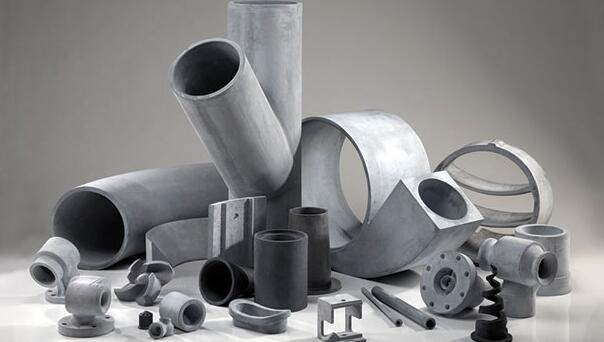
Silicon Carbide (SiC) ceramics are a new generation of advanced technical ceramics that have common applications in various industrial fields due to their excellent properties such as high hardness, high thermal conductivity, and high resistance to thermal shock and wear.
In CNC machining, SiC ceramics have been increasingly used to produce cutting tools, wear parts, and structural components. Besides, The high hardness of SiC ceramics makes it ideal for machining tough and hard materials such as high-strength alloys, hardened steels, and superalloys. Its high thermal conductivity also allows for efficient heat dissipation during machining, reducing tool wear and improving cutting speed and accuracy.
Additionally, SiC ceramics are highly resistant to thermal shock and have good chemical stability, making them suitable for use in harsh operating environments, such as high-temperature and corrosive environments.
Zirconia Ceramic
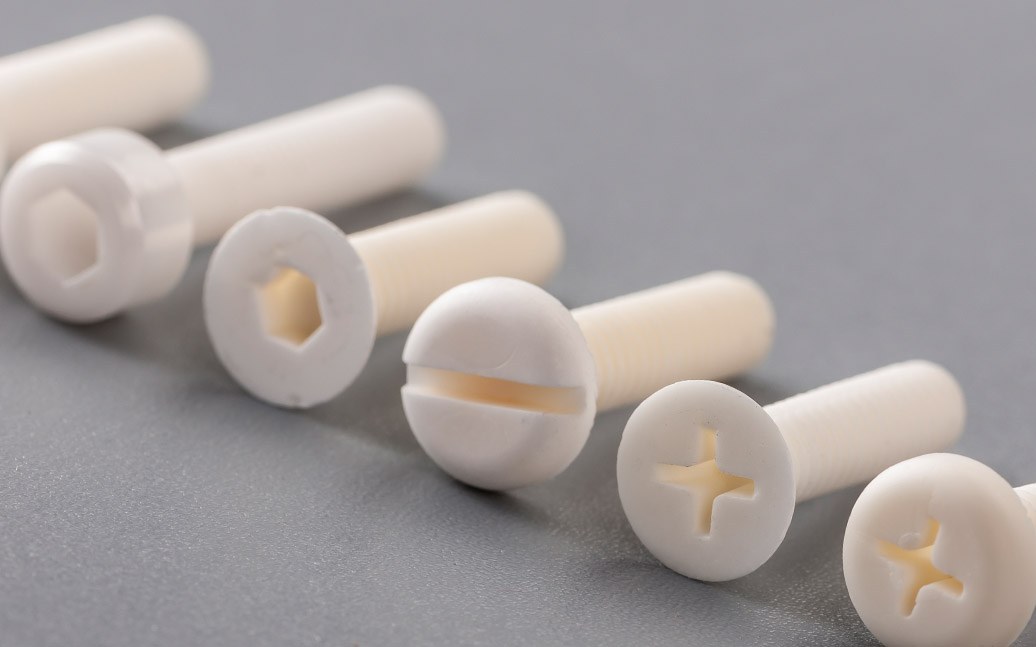
Zirconia, also referred to as zirconium dioxide, is a cutting-edge ceramic material renowned for its exceptional properties. It exhibits remarkable strength, toughness, and resistance to both chemicals and corrosion, making it highly useful in the medical and dental fields. Moreover, its high hardness enhances cutting speeds in machining.
Zirconia boasts exceptional thermal resistance, with a melting point surpassing that of alumina. Compared to other ceramics, it absorbs stress better, making it an ideal material for structural ceramic parts. Its toughness and mechanical strength are unparalleled at room temperature, making CNC machining the most suitable fabrication process.
Various structural ceramic components, such as grinding and dispersing media, ball valves, ball seats, fiber optic pins, cutters, ball bearings, cuttings, and watch cases, widely use CNC-machined zirconia. Additionally, the material’s excellent thermal expansion and insulation properties make it a popular choice for manufacturing functional ceramic parts such as induction heating tubes and heating elements.
Steatite Ceramic
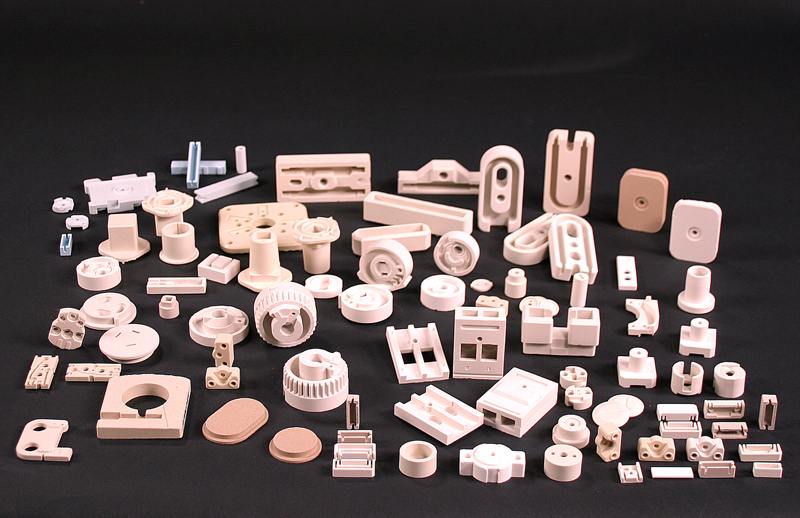
Steatite, also known as high-frequency ceramic, consists mainly of hydrous magnesium silicate, with magnesium metasilicate being present during its crystalline phase. In comparison to other materials discussed in this article, steatite is a cost-effective option. Furthermore, this magnesium silicate-based material offers exceptional electrical resistance, particularly at high temperatures, and has a minimal dielectric loss, low dissipation factor, and impressive mechanical strength. With its ability to endure substantial stress prior to fracturing, steatite is a suitable candidate for fabrication via CNC machining.
Steatite’s low-loss property makes it an excellent material for producing insulators utilized in broadcast antenna equipment. Its capacity to resist heat, along with its dielectric properties, also makes it an outstanding alternative for manufacturing robust and fire-rated terminal blocks.
Quartz
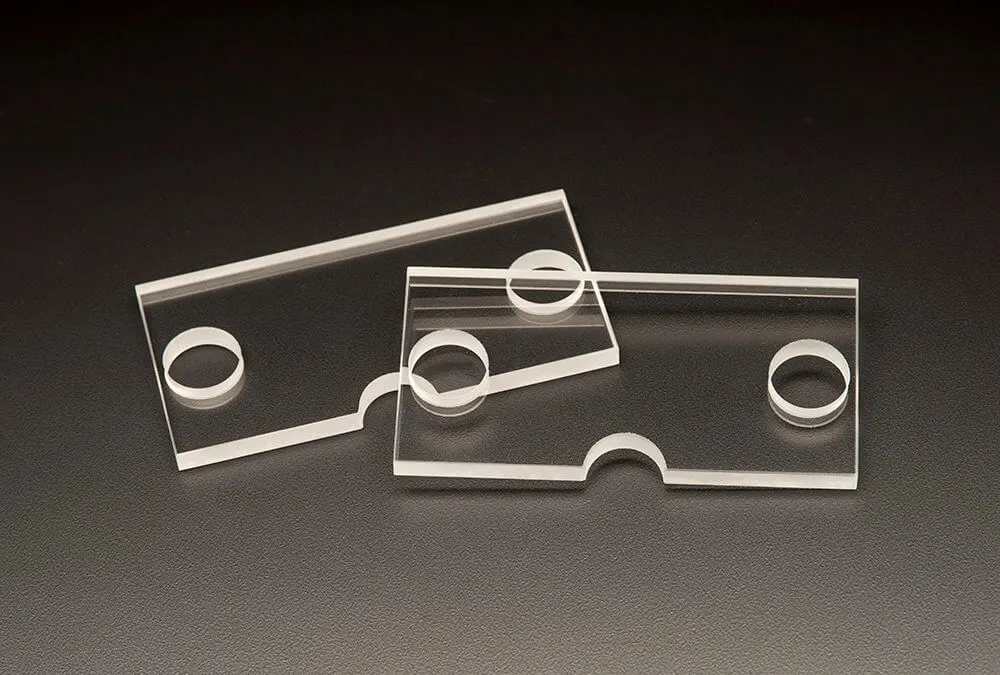
Quartz ceramic is a type of ceramic composed of highly pure silica (silicon dioxide) that boasts exceptional optical and chemical properties. In addition to its superior properties, this material also exhibits excellent tensile strength, good thermal stability, and outstanding thermal insulation, making it a popular choice for lighting and semiconductor applications.
Due to its high hardness, machining quartz ceramic requires the use of robust diamond tools, water jetting, or grinding. This material is particularly well-suited for producing parts that require precision, contamination control, and temperature resistance, making it ideal for CNC machining.
Quartz ceramic is used in a variety of applications, including rocketry, where it is used to manufacture missile nose cones, engine nozzles, and antenna firings. Its thermal stability also makes it useful in the manufacturing of connectors, pipes, valves, heat exchangers, furnace linings, and heat protection equipment for space applications.
Cordierite Ceramic
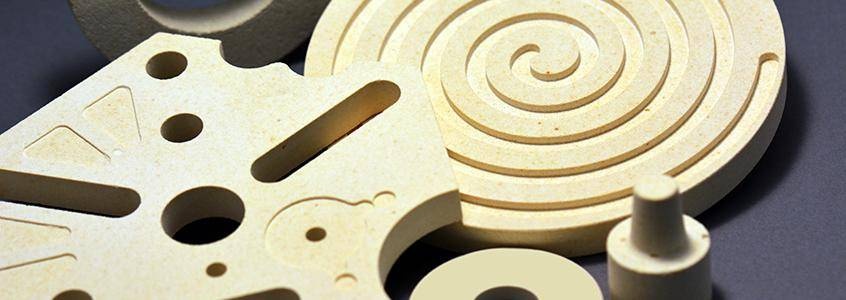
Cordierite ceramic, which consists of magnesium, aluminum, and silicate, is available in various shades, including light blue, light purple, and colorless. It is widely used in the production of parts that require high shock resistance and refractory properties. Cordierite ceramic also boasts exceptional temperature resistance, making it ideal for manufacturing ceramic kiln slabs, saggars, high-temperature heat radiation materials, and electronic packaging materials.
Despite its good electrical insulation properties, cordierite ceramic has lower thermal insulation compared to other ceramic materials. Nevertheless, it can withstand constant heating and cooling without cracking, making it suitable for producing products like catalytic converters.
Mullite Ceramic
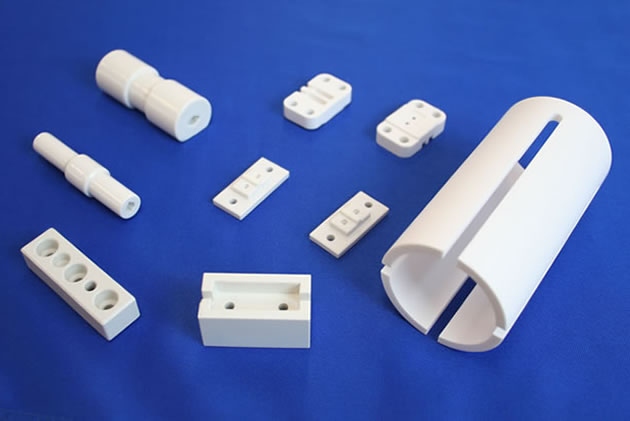
Mullite ceramics are a type of advanced technical ceramic material that is highly valued for their high-temperature stability, excellent thermal shock resistance, low thermal expansion, and good mechanical properties. These properties make them suitable for a wide range of high-temperature and high-stress applications, such as furnace linings, heating elements, and kiln components.
In the field of CNC machining, mullite ceramics are commonly used for producing precise and complex parts for high-temperature applications. CNC machining allows for tight tolerances, intricate shapes, and smooth surface finishes to be achieved in the machined parts. The high-temperature stability of mullite ceramics also enables them to be used in high-heat CNC machining processes, such as laser cutting, milling, and drilling.
However, machining mullite ceramics can be challenging due to its high hardness, low thermal conductivity, and brittle nature. Special cutting tools, cooling systems, and cutting parameters need to be used to prevent cracking and ensure a good surface finish.
Macor
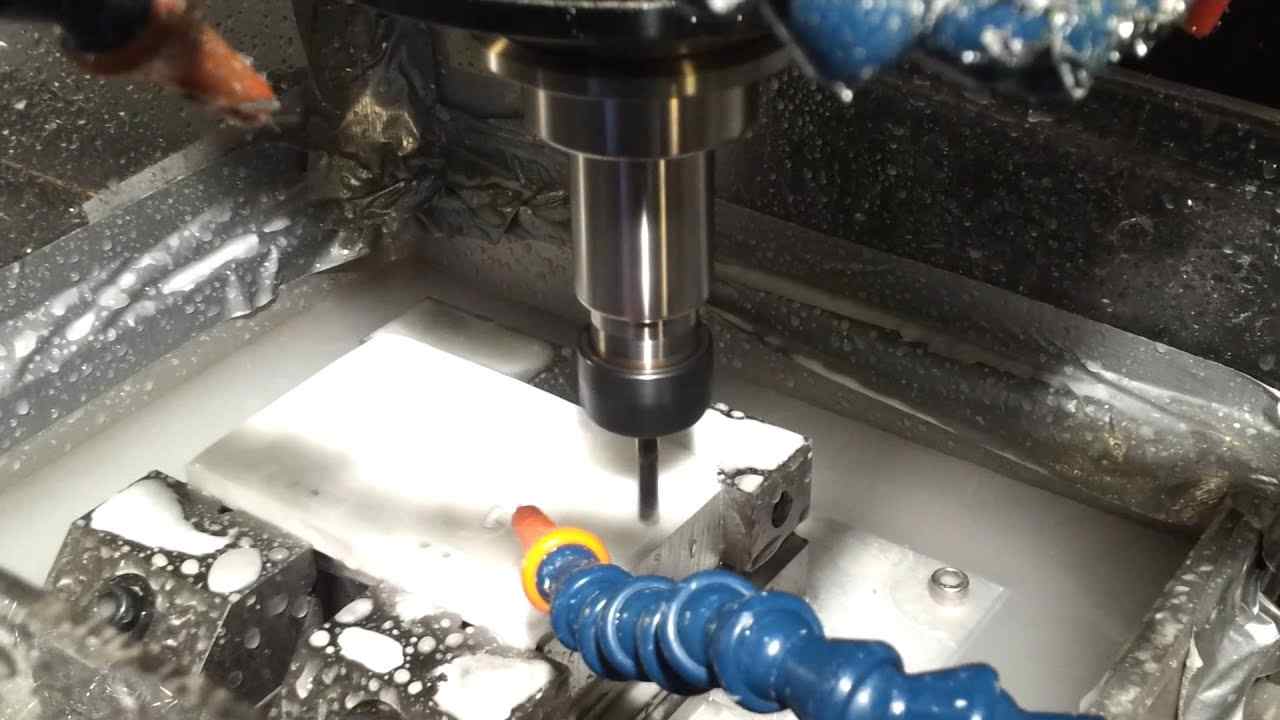
Macor is a type of machinable glass ceramic that has a porcelain-like appearance and is white and odorless. It is made up of approximately 55% fluor phlogopite mica and 45% borosilicate glass. Due to its unique structure, Macor is one of the most machinable materials, comparable in machinability to metals.
This ceramic material has high dielectric strength, excellent physical properties, and high electrical resistivity. To machine Macor effectively, it is recommended to use carbide tools, which have a longer tool life and provide better finishes. The unique structure of Macor keeps micro-fractures created by the CNC machine’s cutting tool localized, thus keeping the ceramic intact.
Macor has a wide range of applications in various industries. For example, it can be used to make spacers, cavities, and reflectors for laser assemblies. It is also useful in the production of electronic parts such as high-voltage insulators and precision coil formers. Macor is also excellent for manufacturing thermal breaks in high-temperature processing equipment. Due to its resistance to radiation, it is commonly used in the nuclear industry as reference block.
Glass
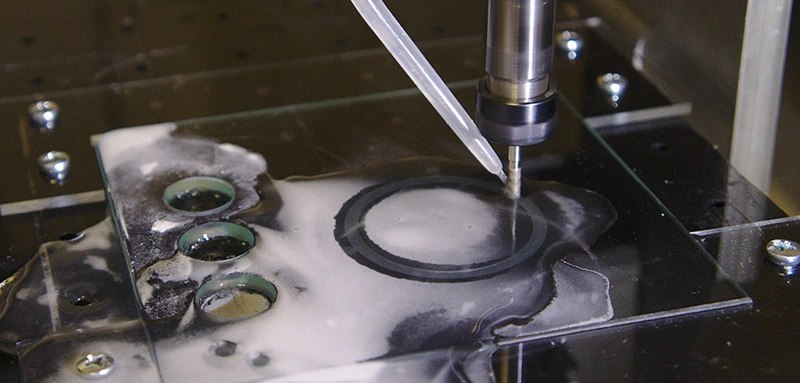
Glass is a remarkable material that comprises substances such as vycor and pyrex. This type of ceramic material boasts impressive qualities, including excellent resistance to impact, high durability, and a low coefficient of thermal expansion. Furthermore, it exhibits outstanding thermal shock resistance, making it suitable for optical applications where it can range from translucent to opalescent and, at times, opaque.
One of the significant advantages of glass is its ease of machinability. It can be CNC machined using the same equipment and methods employed in machining standard metals, such as turning, milling, cutting, tapping, and grinding. Additionally, machining precision with this material is achievable up to 0.005mm, with the ability to control tolerances precisely.
Graphite
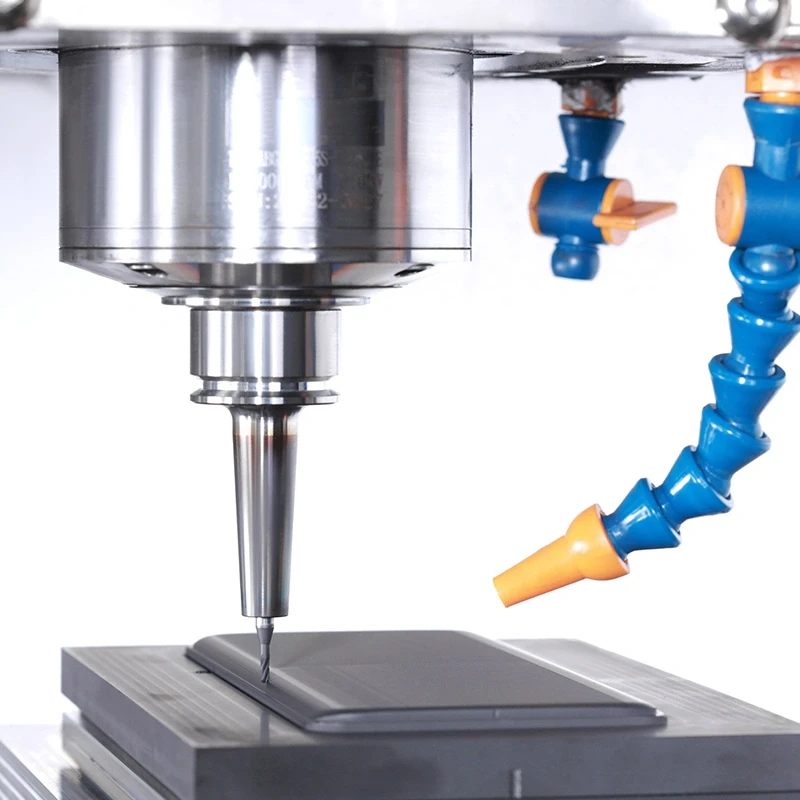
Graphite is a carbon-based ceramic that exhibits a wide range of densities depending on its polymer state. Its exceptional chemical resistance and thermal shock properties make it a highly desirable material for machining ceramic parts or products that require the ability to withstand high temperatures during service.
In addition to these properties, graphite also possesses high thermal resistance, low friction, self-lubrication, excellent electrical and thermal conductivity, and exceptional resistance to neutron radiation. However, the abrasive nature of graphite poses a challenge when it comes to machining, often leading to rapid tool wear. Therefore, diamond-coated tooling is recommended for optimal results.
CNC machined graphite finds numerous applications in various manufacturing industries. For instance, it is used to produce carbon brushes for electrical motors, Magnesia carbon bricks for steel-making furnaces, and automotive components like clutches, brake drums, and pads. The material’s excellent thermal and neutron radiation resistance also makes it ideal for producing moderators in nuclear reactors.
Mycalex
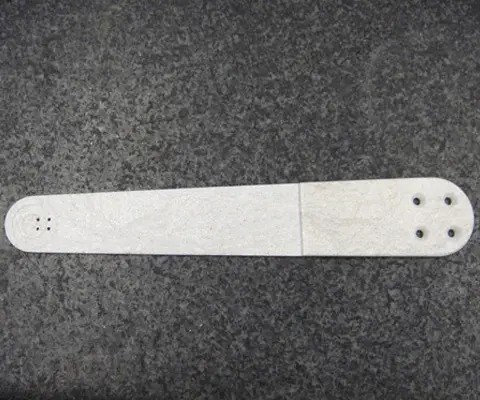
Mycalex, also referred to as Mica, is a highly machinable ceramic that comes in four grades with varying temperature performances. Its exceptional machinability makes it an ideal material for producing components with intricate geometries and small sizes. In addition to its machinability, Mycalex possesses numerous beneficial properties, such as moisture resistance, dimensional stability at high temperatures, and excellent dielectric strength.
The high machinability of Mycalex enables the production of precision components with tight tolerances. This material can undergo a wide range of CNC machining operations, including turning, drilling, milling, and grinding. Mycalex finds applications in the aerospace and defense industry, cryogenics, communication, and electronics. It is also an excellent choice for manufacturing high-vacuum components such as IC test sockets, arc chutes, barriers, gas chromatography, and mass spectrometry.
Here’s a possible revision:
Looking for high-quality ceramic machined parts? Look no further than RapidDirect! Our skilled technicians use state-of-the-art equipment and techniques to manufacture custom ceramic components to your exact specifications.
CNC Machining Operations for Ceramics
CNC machining facilitates the production of parts and products with high precision and tight tolerances. Using this manufacturing procedure on Ceramics makes the production of parts with complex geometries and intricate designs easier. Below are some CNC machining operations best for fabricating ceramics.
CNC Milling
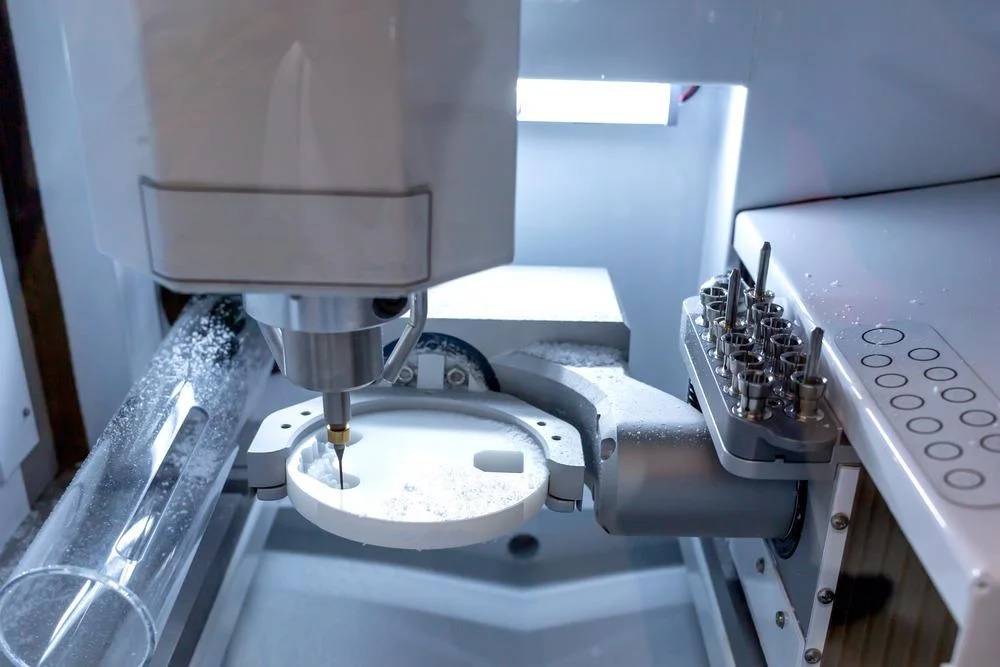
CNC milling for ceramics is a process in which a computer-controlled machine uses a rotating cutting tool to remove material from a ceramic workpiece to create a desired shape or form.
One of the key advantages of CNC milling for ceramics is the ability to produce complex shapes with high precision. The computer-controlled machine guarantees precision and repeatability by cutting exactly as specified in the design file. CNC milling can also produce parts with a smooth surface finish, eliminating the need for additional polishing or finishing steps.
Core Drilling
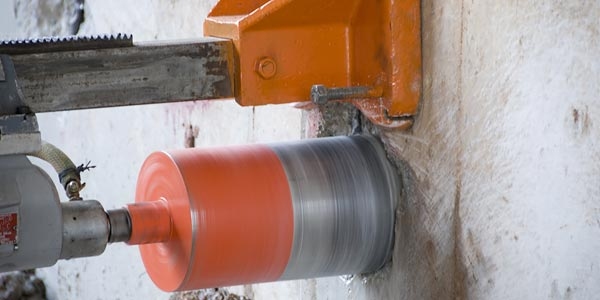
Core drilling is a type of drilling technique that involves the removal of a cylinder of material from a solid block or piece. In ceramic CNC machining, core drilling is used to create holes of a specific diameter in ceramic materials for various purposes. For example, they may create channels for electrical wiring, mount components, or create plumbing or ventilation systems. A CNC machine guides a rotating cutting tool, typically a diamond-tipped drill bit, to create the hole. Computer software controls the size and location of the hole with precision.
However, core drilling can be challenging for machining ceramics because of the hardness and brittleness of ceramics. To prevent breakage, technicians must control the speed of the drill bit carefully and often use a coolant to reduce heat generated by the cutting process. They may also need specialized cutting tools, such as diamond-tipped drill bits, to effectively drill through the material.
Wafer Dicing
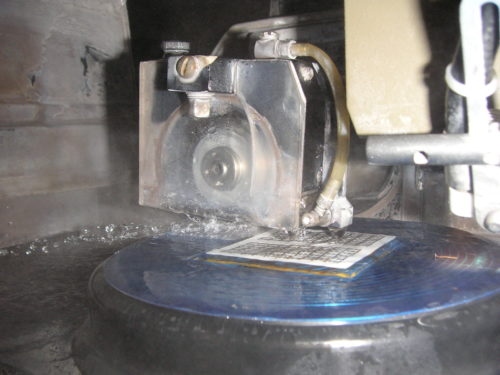
This CNC machining process is ideal for manufacturing ceramic parts like quartz and graphite. Wafer dicing facilitates the separation of dice from a ceramic wafer, achieved through breaking, laser-cutting, mechanical sawing, or scribing. Mounting the wafer on a film frame improves the ease of handling while mounting on glass improves cutting precision.
ID Slicing
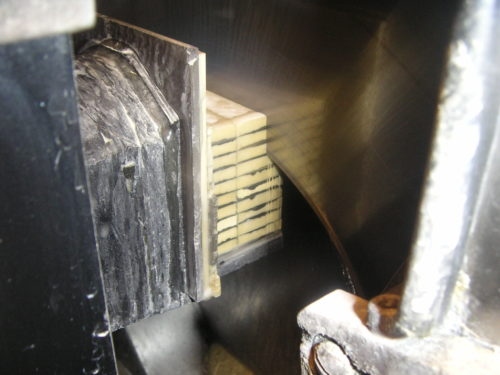
ID slicing, also known as Inner or internal diameter slicing, is a machining process ideal for creating repeated cuts on brittle or hard materials. It involves using an ID-slicing saw blade composed of a diamond-plated internal diameter and an annular apparatus. Besides, this saw blade’s components and configuration help enhance cutting accuracy, minimizing kerf loss.
This ceramic machining process for fabricating ceramics is quite easy, as it does not require extensive setup procedures. Additionally, it makes production more cost-effective.
Surface Grinding
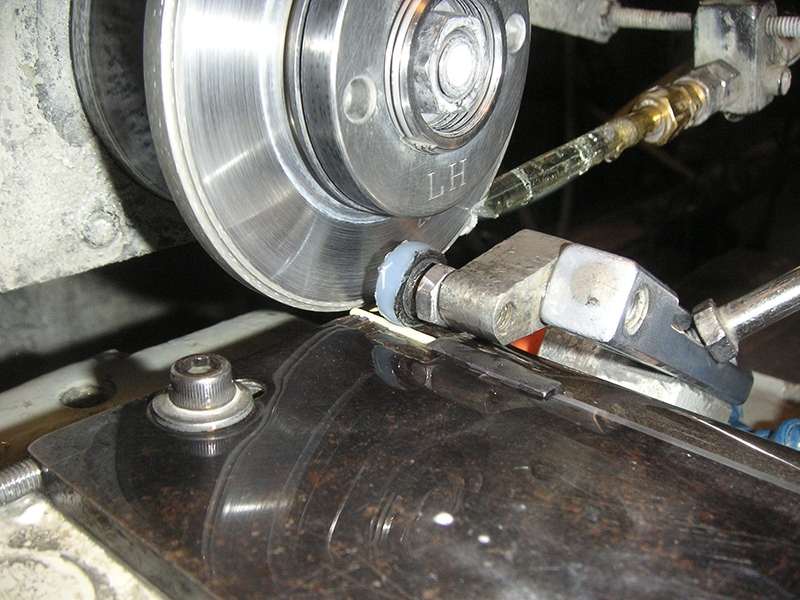
Surface grinding is a machining process that involves the use of a grinding wheel to remove material from the surface of a workpiece. When it comes to ceramics, surface grinding is often used to create precise and smooth surfaces on ceramic components.
Surface grinding of ceramics requires a high level of precision, as any imperfections in the surface can affect the performance of the ceramic component. Manufacturers often use the process to create flat and parallel surfaces on ceramic components, and they also use it to remove any surface defects or damage.
Advantages of CNC Ceramic
There are many methods for fabricating ceramics, ranging from waterjet cutting to laser cutting and even using the kiln. However, here are some reasons why it is better to manufacture ceramics through the process of CNC machining.
Versability
Ceramic CNC machining is a highly precise process that allows for the creation of complex and intricate parts from ceramic materials. The use of CNC equipment and software allows for the precise control of cutting and shaping tools, resulting in high-quality, accurate parts that meet even the most demanding specifications.
Cost-effective
Compared to other manufacturing methods like laser cutting and waterjet cutting, fabricating ceramics using CNC can be quite cost-effective. Cost-effectiveness is due to the lower number of mistakes recorded as well as its high rate of output as compared to laser cutting. Besides, the cost of CNC machining for manufacturing ceramics is considerably lower than that for laser cutting.
Great Properties
Ceramics have a lot of great properties that make them ideal for CNC machining, including durability and hard-wearing. They also have great strength and hardness and low electrical and thermal conductivity. Besides, most have high-temperature resistance, fracture toughness, and mechanical strength.
Scalability
CNC machining ceramics is a scalable manufacturing process. In other words, CNC machining makes it possible to increase or decrease the number of ceramic parts produced on market demand. This reduces material waste as products are manufactured on demand while also ensuring capital is not tied up.
Disadvantages of CNC Ceramic
While ceramic CNC machining has some advantages, disadvantages also abound. Below are some disadvantages of ceramic CNC machining.
Material Brittleness
Ceramic materials are strong and hard but brittle with low impact resistance due to their crystalline structure lacking the ductility of metals. This makes them susceptible to cracking and chipping when stressed. CNC machining can worsen stress. But specialized cutting tools like diamond-tipped cutters, slow cutting speeds, and low feed rates can reduce stress and prevent cracking or chipping.
Poor Mechinablity
One of the main challenges with machining ceramics is their hardness. Ceramics are typically much harder than the cutting tools used in CNC machining. This can result in excessive wear and damage to the cutting tool. This can lead to increased tooling costs, longer machining times, and lower-quality parts.
Long Lead Times
Long lead times often accompany ceramic CNC machining due to the nature of ceramic materials and the machining process. Ceramics are harder and more brittle than metals, making the machining process more demanding and slow. The high precision demanded by ceramic machining also requires specialized tools and equipment, further prolonging the lead time.
Tips When Designing and CNC Machining Ceramic
Ceramics have unique properties, including brittleness and low tensile strength. It is important to keep these properties in mind during the product design phase, as it would save you costs and time in the long term.
Here are some other tips for successfully designing and machining CNC ceramic.
- Utilize wall designs and shapes that are simple instead of complex ones
- Instead of oval designs, use round ones
- Avoid sudden changes in cross-section
- Use a modular design
- Convert tensile stress to compressive stress to enable the ceramic material to absorb more stress without fracturing.
- Turn away from sharp and long edges.
Conclusion
Ceramic materials find application in a wide range of mechanical, optical, and electrical appliances. While there are several ways to fabricate ceramics, using a CNC machine is one way to ensure CNC precision machining and tight tolerances. However, the properties of ceramics, like brittleness and low tensile strength, make this process challenging. It is often best to leave machining these materials to professionals like RapidDirect.
RapidDirect is a reliable manufacturing company with years of experience in CNC machining various materials, including ceramics. We employ a variety of machining design guidelines to ensure your ceramic product meets your specification. Want to make CNC machined ceramic parts with high precision? Upload your design to our platform to get an instant quote today.


